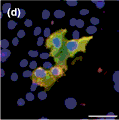Department of Chemistry
Document Type
Article
Date of this Version
April 2004
Abstract
Fumonisins are polyketide-derived mycotoxins produced by Fusarium verticillioides, a fungal pathogen of corn plants. Although a gene cluster for the biosynthesis of fumonisins has been cloned, the biosynthetic pathway is still not clear. We have used three gene-disrupted mutants, designated ΔFUM1, ΔFUM6, and ΔFUM8, to study the early steps of the pathway. Fumonisins were not produced in single-strain cultures of the ΔFUM1, ΔFUM6, and ΔFUM8 mutants. However, fumonisins were produced by ΔFUM1 or ΔFUM8 mutants when they were cocultured with the ΔFUM6 mutant. No fumonisins were produced when the ΔFUM1 and ΔFUM8 mutants were cocultured. These results suggest that the ΔFUM6 mutant produces a fumonisin intermediate that can be further metabolized by fumonisin biosynthetic enzymes in the ΔFUM1 and ΔFUM8 mutants. To isolate the potential intermediates produced by ΔFUM6, we followed a time course of cocultures of the ΔFUM1 and ΔFUM6 and the ΔFUM8 and ΔFUM6 mutants. Liquid chromatographic-mass spectrometric data suggested that metabolites having the general carbon skeleton of fumonisins with 1-4 hydroxyl groups were accumulated over a 7-day period. These results indicate that fumonisin biosynthesis starts with Fum1p-catalyzed carbon-chain assembly followed by the Fum8p-catalyzed alanine condensation. The resulting product then can be further oxidized by Fum6p and other enzymes.



Comments
Published in J. Agric. Food Chem. 2004, 52, 2855-2860.